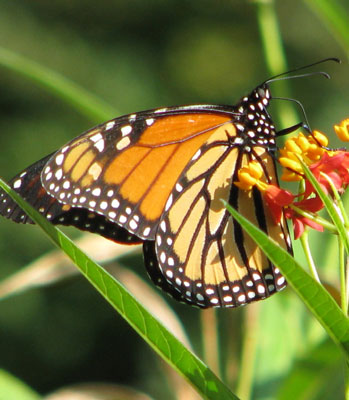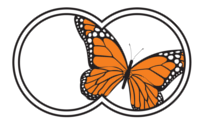Monarch Biology
 Monarch butterflies (Danaus plexippus) are native to North and South America. In the 1800's, however, they spread to other parts of the world. Monarchs were first seen on Hawaii in the 1840's, and then throughout many South Pacific islands in the 1850's and 1860's (Ackery and Vane-Wright 1984). In the early 1870's, the first monarchs were reported in Australia and New Zealand (Gibbs 1994). It is not clear exactly how and why this emigration occurred. One possibility is that monarchs were transported by ships, either as larvae that found their way onboard from shipyard milkweed plants, or as adult monarchs that happened to land on ocean-going vessels. It is most likely that humans were involved in the process, but it is not known to what extent. Because North American monarchs often fly over 2,200 km during their migration, it is always possible that some made the journey on their own (Vane-Wright 1993). In the Western Hemisphere, up to six subspecies of D. plexippus are currently recognized with caveats that some may be forms of others. While there is some disagreement among experts regarding exact distribution ranges of subspecies, it is widely accepted that D. p. plexippus is the widespread migratory subspecies found throughout North America and Central America. D. p. megalippe is generally considered the widespread non-migratory subspecies found in tropical and subtropical areas from the Caribbean and Central America south to around the Ucayali-Amazon rivers in Peru and Brazil. The other subspecies are found primarily on certain Caribbean Islands and in northern South America. The foci of this website are the North American migratory populations, i.e. those monarchs that migrate to overwintering grounds in central Mexico and the west coast of the USA.
Monarch butterflies (Danaus plexippus) are native to North and South America. In the 1800's, however, they spread to other parts of the world. Monarchs were first seen on Hawaii in the 1840's, and then throughout many South Pacific islands in the 1850's and 1860's (Ackery and Vane-Wright 1984). In the early 1870's, the first monarchs were reported in Australia and New Zealand (Gibbs 1994). It is not clear exactly how and why this emigration occurred. One possibility is that monarchs were transported by ships, either as larvae that found their way onboard from shipyard milkweed plants, or as adult monarchs that happened to land on ocean-going vessels. It is most likely that humans were involved in the process, but it is not known to what extent. Because North American monarchs often fly over 2,200 km during their migration, it is always possible that some made the journey on their own (Vane-Wright 1993). In the Western Hemisphere, up to six subspecies of D. plexippus are currently recognized with caveats that some may be forms of others. While there is some disagreement among experts regarding exact distribution ranges of subspecies, it is widely accepted that D. p. plexippus is the widespread migratory subspecies found throughout North America and Central America. D. p. megalippe is generally considered the widespread non-migratory subspecies found in tropical and subtropical areas from the Caribbean and Central America south to around the Ucayali-Amazon rivers in Peru and Brazil. The other subspecies are found primarily on certain Caribbean Islands and in northern South America. The foci of this website are the North American migratory populations, i.e. those monarchs that migrate to overwintering grounds in central Mexico and the west coast of the USA.
